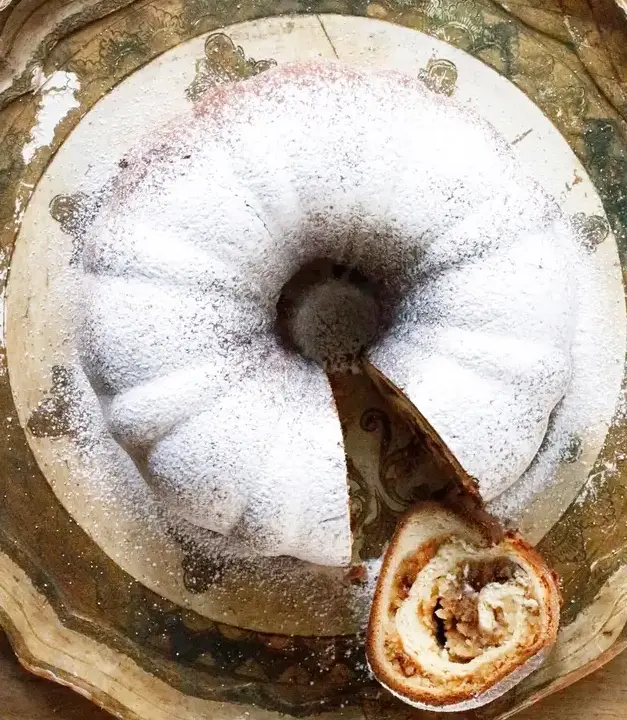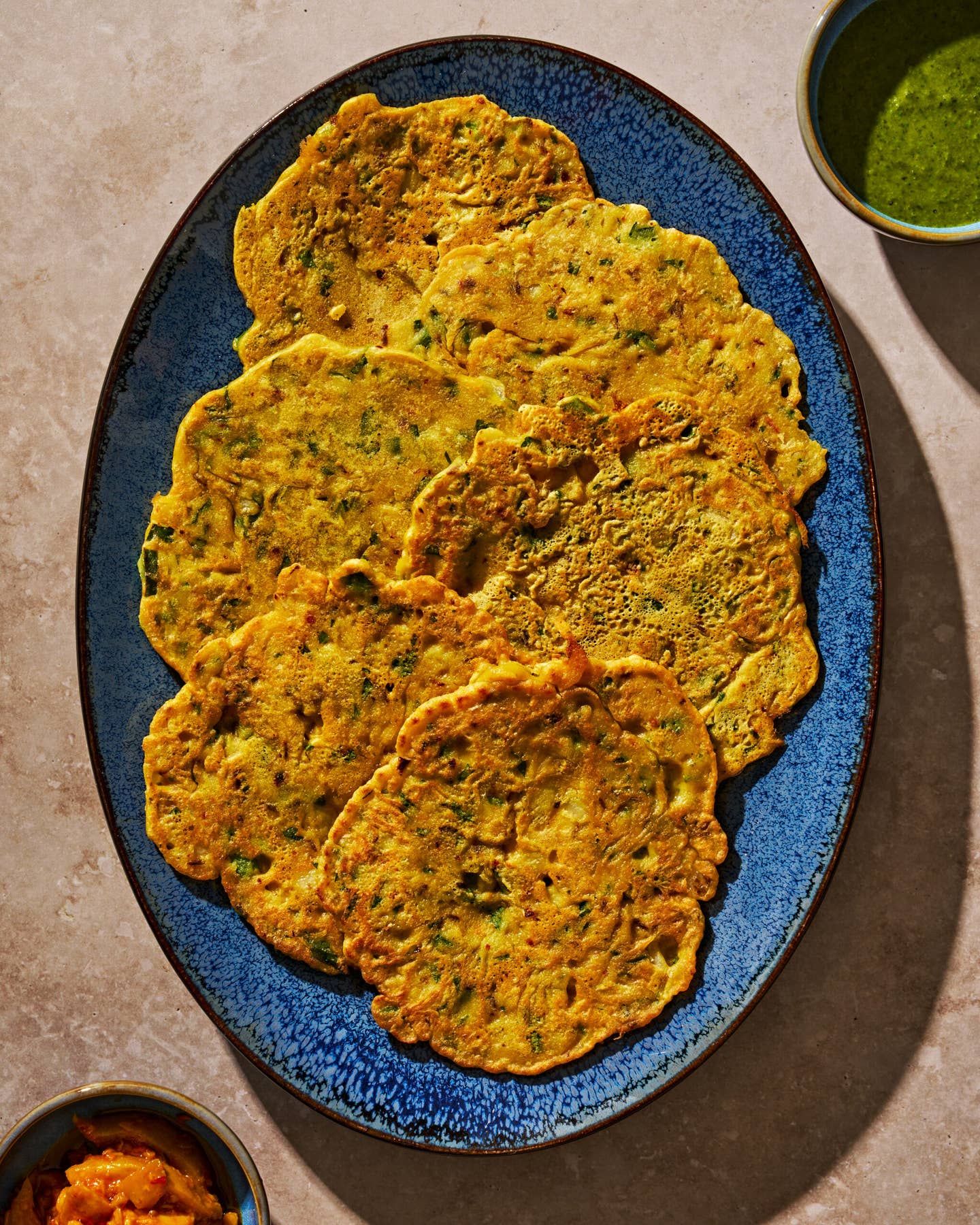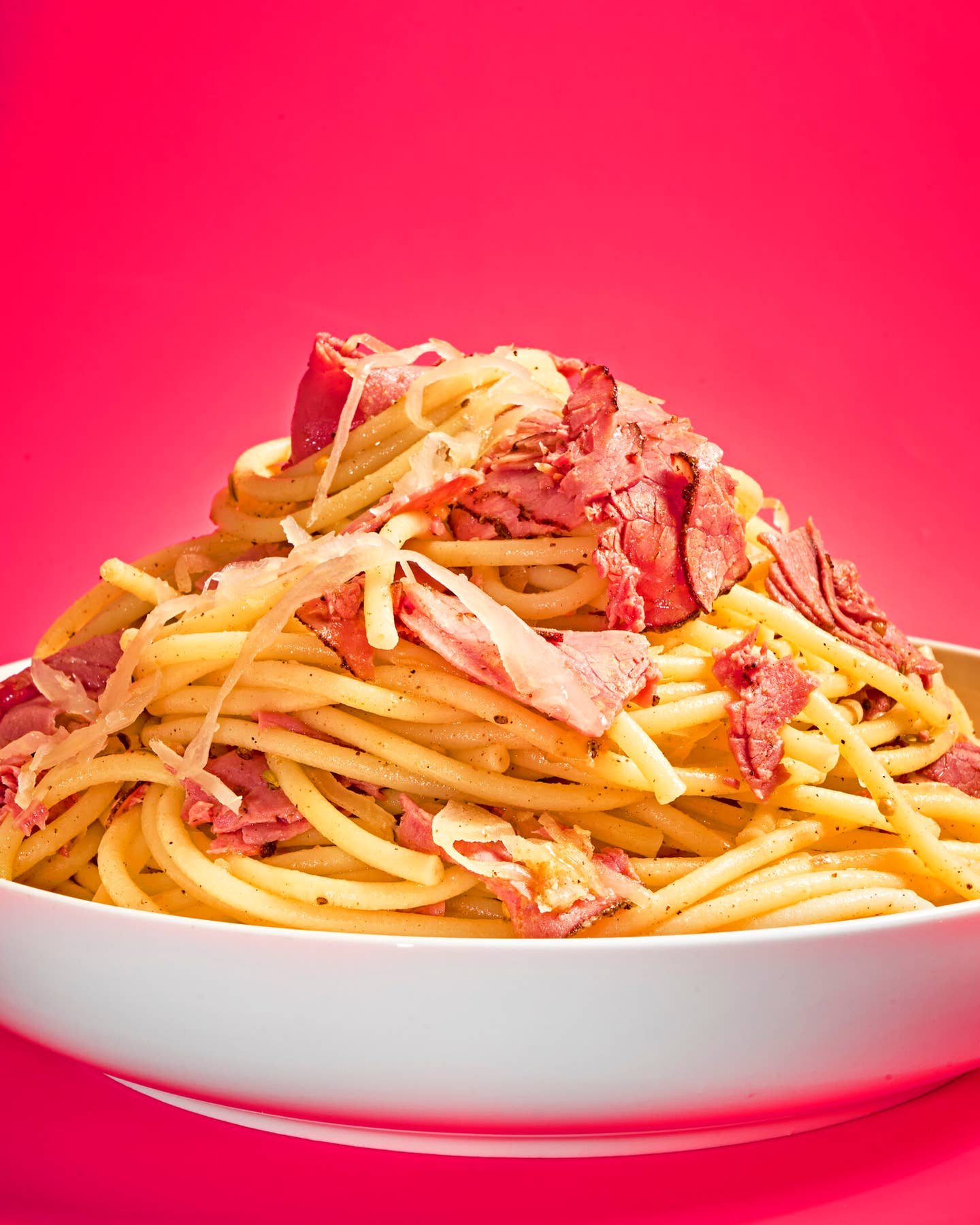
This Slovenian dessert, traditionally an Easter treat, is adapted from a recipe from Romana Bohinc of Bled Island’s Potičnica bakery. If time allows, let the stewed figs rest for a night or two in the fridge—they’re more aromatic that way. Potica (poh–TEE–tsa) is traditionally baked in a handmade fluted earthenware tube pan called a potičnica (po-teech-nee-tsa), but a nonstick metal Bundt pan works just fine; if you happen to have one of the former (which sometimes turns up on eBay), add 5 minutes to the baking time.
Featured in: Potica: How They Make It On Slovenia’s Bled Island
Equipment
Ingredients
For the dough
- 2 Tbsp. plus ¾ tsp. (¾ oz.) active dry yeast
- ½ cup (3¾ oz.) sugar, divided
- 3 cups plus 2 Tbsp. (1 lb.) all-purpose flour, divided, plus more for kneading
- ⅔ cup room temperature whole milk, divided
- 1 stick (4 oz.) unsalted butter, melted and cooled, plus more for greasing
- ¾ tsp. salt
- 3 large egg yolks
- 2 tsp. lemon zest
- 1½ tsp. vanilla extract
- Fine cornmeal, for dusting
For the filling
- 1 lb. blanched hazelnuts, ground in a food processor to the texture of coarse polenta (4½ cups)
- ¼ cup plus 2 Tbsp. honey, divided
- 3 tbsp. honey liqueur (or substitute 1 Tbsp. honey dissolved in 2 Tbsp. brandy), divided
- 13 dried white figs (9 oz.), finely sliced
- 3 tbsp. lemon juice
- 1 cup heavy cream
- ¾ tsp. salt
- 3 large egg whites
- ⅓ cup (2½ oz.) sugar
- Confectioner’s sugar, for dusting
ADVERTISEMENTADAD
Instructions
Step 1
In a small bowl, whisk together the yeast, 1 teaspoon sugar, 2 tablespoons flour, and ¼ cup milk. Set aside until bubbles form on the surface and the mixture looks frothy, about 10 minutes.
Step 2
To the bowl of a stand mixer fitted with the paddle attachment, add the butter, salt, and the remaining sugar and mix on medium speed until thick and uniform. Add the yolks one at a time, beating well after each addition and using a silicone spatula to scrape down the bottom and sides of the bowl occasionally. Add the lemon zest, vanilla, the remaining milk, and the yeast mixture, and continue mixing until combined. Turn the mixer off and swap out the paddle attachment for the dough hook. Add the remaining flour and mix on low speed until a shaggy dough comes together, 2–3 minutes. Lightly flour a clean work surface then turn the dough out onto it. Knead the dough until smooth and elastic, 8–10 minutes. Grease a large bowl with butter, transfer the dough into it, cover loosely with plastic wrap, and set aside in a warm place until it nearly doubles in size, about 1 hour.
Step 3
Meanwhile, prepare the filling: To a large bowl, add the hazelnuts, 3 tablespoons honey, and 1 tablespoon brandy, and set aside. To a small pot, add the figs, lemon juice, and the remaining honey and brandy. Bring to a boil over medium-high heat, then lower the heat to simmer and cook until the figs are soft and plump and have absorbed most of the liqui, 5–10 minutes. Transfer the figs and any remaining liquid to a small bowl and set aside to cool to room temperature.
Step 4
Wipe out the pot, then add the cream and salt and return the pot to medium heat; cook just until the cream is hot to the touch (about 140° F) without boiling. Remove from heat, then stir the hot cream mixture into the reserved hazelnut mixture. Set aside to cool to room temperature.
Step 5
To the clean bowl of a stand mixer fitted with the whisk attachment, add the egg whites and sugar and beat just until the mixture begins to hold stiff peaks. Transfer the meringue to the hazelnut mixture and use a silicone spatula to gingerly and gently fold it into the nut mixture to combine without deflating the whites. (A few streaks of white may remain).
Step 6
Butter and flour a standard (12-cup) Bundt pan. Generously dust a clean work surface with cornmeal, then turn the dough out onto it. Sprinkle the surface of the dough with cornmeal, press it gently to deflate, then use a rolling pin to sheet it out to a 20- by 15-inch rectangle, adding a little more cornmeal as needed to prevent sticking. Position the rectangle with one of the longest sides parallel to the edge of the surface closest to you, then scoop the hazelnut mixture over the dough. Use a spatula or the back of a spoon to spread the filling evenly over the surface all the way to the edges. Distribute the figs and their juices evenly over the hazelnut mixture, then, starting with the edge furthest from you, roll the dough into a thick log, pulling towards you slightly with each rotation to ensure a tight spiral. Using a serrated knife, trim the ends to make a uniform, 20-inch long cylinder, then join the cut ends to form a circle, pinching the seams to seal. Transfer the circle of dough to the Bundt pan, seam-side-up, pressing the top to fit it snugly in the pan. Cover loosely with plastic wrap and set aside in a warm place until once again nearly doubled in size, about 1 hour more.
Step 7
Meanwhile, preheat the oven (with one of its racks positioned in the center) to 350°F. Immediately before baking, use a wooden skewer to stab the dough all over, all the way to the bottom of the pan (this will prevent air bubbles from forming in the oven). Transfer to the oven and bake until the top is golden brown and a cake tester inserted into the center comes out with a few crumbs attached, 40–45 minutes. Cool the cake in the pan for 10 minutes before inverting onto a wire rack to finish cooling completely. Sift confectioners’ sugar generously over the top just before slicing and serving.
Keep Reading
Continue to Next Story
ADVERTISEMENTADAD










